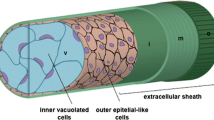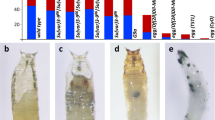Abstract
The sog, a fly homologue of the vertebrate chordin, is expressed in the presumptive neurogenic ectoderm and also the ventral midline during Drosophila embryogenesis. Previously, two enhancers, called the primary and shadow enhancer, respectively, were found to direct sog expression in the neurogenic ectoderm. However, efforts to identify an enhancer that directs sog expression in the ventral midline have failed. Here, we present evidence that the sog shadow enhancer has dual activities to direct sog expression in the neurogenic ectoderm as well as the ventral midline. Systematic truncation analyses employing transgenic embryos revealed that about a 680-bp region within the shadow enhancer is necessary and sufficient for midline enhancer activity. Intriguingly, midline enhancer activity does not appear to depend on binding sites for Sim, because distal and proximal elements critical for sog midline expression within the 680-bp region do not have any canonical Sim binding sites.




Similar content being viewed by others
References
Ashe HL, Levine M (1999) Local inhibition and long-range enhancement of dpp signal transduction by sog. Nature 398:427–431
Biehs B, Francois V, Bier E (1996) The Drosophila short gastrulation gene prevents dpp from autoactivating and suppressing neurogenesis in the neuroectoderm. Genes Dev 10:2922–2934
Campos-Ortega JA, Hartenstein V (1985) The embryonic development of Drosophila Melanogaster. Springer, Heidelberg
Crooks GE, Hon G, Chandonia JM, Brenner SE (2004) WebLogo: a sequence logo generator. Genome Res 14:1188–1190
Farley E, Levine M (2012) HOT DNAs: a novel class of developmental enhancers. Genes Dev 26:873–876
Foo SM, Sun Y, Lim B, Ziukaite R, O’Brien K et al (2014) Zelda potentiates morphogen activity by increasing chromatin accessibility. Curr Biol 24:1341–1346
Francois V, Solloway M, O’Neill JW, Emery J, Bier E (1994) Dorsal-ventral patterning of the drosophila embryo depends on a putative negative growth factor encoded by the short gastrulation gene. Genes Dev 8:2602–2616
Holley SA, Jackson PD, Sasai Y, Lu B, De Robertis EM et al (1995) A conserved system for dorsal-ventral patterning in insects and vertebrates involving sog and chordin. Nature 376:249–253
Hong JW, Hendrix DA, Levine MS (2008a) Shadow enhancers as a source of evolutionary novelty. Science 321:1314
Hong JW, Hendrix DA, Papatsenko D, Levine MS (2008b) How the dorsal gradient works: insights from postgenome technologies. Proc Natl Acad Sci USA 105:20072–20076
Hong JW, Park KW, Levine MS (2013) Temporal regulation of single-minded target genes in the ventral midline of the Drosophila central nervous system. Dev Biol 380:335–343
Ip YT, Park RE, Kosman D, Bier E, Levine M (1992) The dorsal gradient morphogen regulates stripes of rhomboid expression in the presumptive neuroectoderm of the Drosophila embryo. Genes Dev 6:1728–1739
Kvon EZ, Stampfel G, Yanez-Cuna JO, Dickson BJ, Stark A (2012) HOT regions function as patterned developmental enhancers and have a distinct cis-regulatory signature. Genes Dev 26:908–913
Liang HL, Nien CY, Liu HY, Metzstein MM, Kirov N et al (2008) The zinc-finger protein zelda is a key activator of the early zygotic genome in Drosophila. Nature 456:400–403
Markstein M, Markstein P, Markstein V, Levine MS (2002) Genome-wide analysis of clustered dorsal binding sites identifies putative target genes in the Drosophila embryo. Proc Natl Acad Sci USA 99:763–768
Menne TV, Luer K, Technau GM, Klambt C (1997) CNS midline cells in Drosophila induce the differentiation of lateral neural cells. Development 124:4949–4958
modENCODE Consortium, Roy S, Ernst J, Kharchenko PV, Kheradpour P et al (2010) Identification of functional elements and regulatory circuits by Drosophila modENCODE. Science 330:1787–1797
Nambu JR, Franks RG, Hu S, Crews ST (1990) The single-minded gene of Drosophila is required for the expression of genes important for the development of CNS midline cells. Cell 63:63–75
Papatsenko D (2007) ClusterDraw web server: a tool to identify and visualize clusters of binding motifs for transcription factors. Bioinformatics 23:1032–1034
Rubin GM, Spradling AC (1982) Genetic transformation of Drosophila with transposable element vectors. Science 218:348–353
Satija R, Bradley RK (2012) The TAGteam motif facilitates binding of 21 sequence-specific transcription factors in the Drosophila embryo. Genome Res 22:656–665
Schmidt I, Franzdottir SR, Edenfeld G, Rodrigues F, Zierau A et al (2011) Transcriptional regulation of peripheral glial cell differentiation in the embryonic nervous system of Drosophila. Glia 59:1264–1272
Shimmi O, Umulis D, Othmer H, O’Connor MB (2005) Facilitated transport of a dpp/scw heterodimer by sog/tsg leads to robust patterning of the drosophila blastoderm embryo. Cell 120:873–886
Small S, Blair A, Levine M (1992) Regulation of even-skipped stripe 2 in the Drosophila embryo. EMBO J 11:4047–4057
Swanson HI, Chan WK, Bradfield CA (1995) DNA binding specificities and pairing rules of the ah receptor, ARNT, and SIM proteins. J Biol Chem 270:26292–26302
Wharton KA Jr, Franks RG, Kasai Y, Crews ST (1994) Control of CNS midline transcription by asymmetric E-box-like elements: similarity to xenobiotic responsive regulation. Development 120:3563–3569
Wieschaus E, Nusslein-Volhard C, Jurgens G (1984) Mutations affecting the pattern of the larval cuticle in Drosophila melanogaster III. Zygotic loci on the X-chromosome and fourth chromosome. Roux’s Arch Dev Biol 193:296–307
Wolpert L (1969) Positional information and the spatial pattern of cellular differentiation. J Theor Biol 25:1–47
Wolpert L (2011) Positional information and patterning revisited. J Theor Biol 269:359–365
Zeitlinger J, Zinzen RP, Stark A, Kellis M, Zhang H et al (2007) Whole-genome ChIP-chip analysis of dorsal, twist, and snail suggests integration of diverse patterning processes in the Drosophila embryo. Genes Dev 21:385–390
Zhu LJ, Christensen RG, Kazemian M, Hull CJ, Enuameh MS et al (2011) FlyFactorSurvey: a database of Drosophila transcription factor binding specificities determined using the bacterial one-hybrid system. Nucleic Acids Res 39:D111–D117
Zinzen RP, Cande J, Ronshaugen M, Papatsenko D, Levine M (2006) Evolution of the ventral midline in insect embryos. Dev Cell 11:895–902
Acknowledgments
This work was supported by the National Research Foundation of Korea (NRF) Grants funded by the Korean Government (MSIP and MOE) (NRF-2010-0002792 and NRF-2012R1A1 A2038502).
Conflict of interest
The authors declare that there are no conflicts of interest.
Author information
Authors and Affiliations
Corresponding author
Electronic supplementary material
Below is the link to the electronic supplementary material.
Rights and permissions
About this article
Cite this article
Shin, DH., Hong, JW. The shadow enhancer of short gastrulation also directs its expression in the ventral midline of the Drosophila embryo. Genes Genom 37, 743–750 (2015). https://doi.org/10.1007/s13258-015-0302-5
Received:
Accepted:
Published:
Issue Date:
DOI: https://doi.org/10.1007/s13258-015-0302-5




